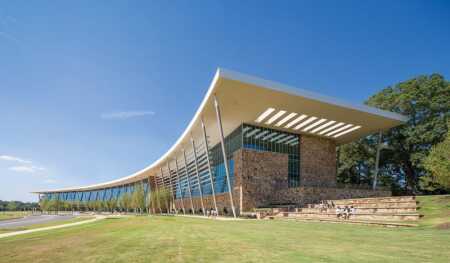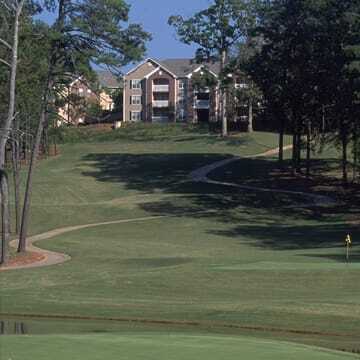The nine-hole golf course at the Charles R. Drew Charter School gets a lot of use during an average school day. Gym teachers hold classes there, and students at this elementary and middle school in Atlanta’s East Lake district can study the sport as an elective. The school’s players have won titles and gone on to earn college scholarships.
That golf is a dedicated subject at a southern school is not exactly remarkable—but how this came to be is.
Two decades ago, the golf course was closed—and as decrepit as the East Lake Meadows housing project that sat on its edge. The project had more broken windows than intact ones; of the 650 units, only 400 were occupied. Residents openly bought, sold, and used illegal drugs on the trash-strewn grounds. About 90 percent of residents had been a victim of violent crime, and only 5 percent of fifth graders at the local elementary school met state math standards. Predictably, the area had seen no private investment in 40 years.
Related: HowHousingMatters.org | Register for the Housing Opportunity Conference 2015
“The longer [children] stayed in their neighborhood schools, the further behind they fell,” says Carol Naughton, senior vice president of Purpose Built Communities, a consulting firm that helps revitalize neighborhoods and which grew out of the stunning success that eventually came about at East Lake.
Today, because of Purpose Built Communities and the efforts of local organizations, the Drew elementary school ranks number one among 70 in Atlanta on the Georgia Department of Education College and Career Ready Performance Index, and the middle school ranks third among 19. High school graduation rates for participants in the neighborhood’s after-school program have soared, hitting 90 percent in 2012, compared with 30 percent for neighborhood teens before redevelopment. The remarkable results reflect what researchers have been trumpeting for years: sound housing is as critical to educational success as the instructors in the classrooms and the resources used to teach children.
The changes in Atlanta began with a single newspaper column in 1993: Atlanta-based developer Tom Cousins was shocked to read that 70 percent of inmates in New York state prisons came from just eight New York City neighborhoods. Cousins wondered whether what happened in New York festered in Georgia, too. He investigated and found that East Lake Meadows was a major feeder for Georgia state prisons.
Cousins brought together a coalition of leaders—ranging from the head of the Atlanta Housing Authority to a tenants’ group leader at East Meadows—to help reimagine the neighborhood and schools. They created a holistic approach to changing the community that included the creation of high-quality mixed-income housing, a “cradle to college” pipeline spanning early learning through a college preparatory high school, and wellness services.
The Atlanta Housing Authority razed East Lake Meadows and partnered with the newly created East Lake Foundation to redevelop the site with 542 new units of garden apartments, townhouses, and villas divided equally between market-rate and affordable housing. Phase I was completed in 1998, and the final phase of housing was fully occupied by 2001. Half the tenants earn below 30 percent of the area median income.
Initially, the development provided an after-school golf academy for children in the neighborhood, but Cousins wanted to strengthen education in the classroom as well. In 1999, several years after Cousins had his epiphany, the neighborhood elementary school was demolished and replaced with Drew Charter School, Atlanta’s first charter school. Cousins led the fundraising efforts to build the school and worked with local officials to ensure that the school could bring in new leadership and have autonomy over the curriculum. It was initially opened offering kindergarten through eighth grade, but Drew Senior Academy, a high school, was added in 2014 with a freshman class of 100 students. Wellness services are provided at both the school and housing development.
The East Lake elementary and middle schools added an hour and a half to the school day and extended the school year by five days; employ the STEAM (science, technology, engineering, arts, and mathematics) designed curriculum; and collaborate with businesses, community centers, and universities on many of the services and programs. The high school adopted the same program and, based on the test scores of the students admitted, is already on track to be as successful as the school’s lower grades.
The nine-hole school golf course is funded through the revitalization of the East Lake Country Club golf course, which also holds a major Professional Golfers’ Association (PGA) tournament each year to help raise funds for the school’s course. About 800 of the Drew students use the course. It originally had 18 holes, but land taken up by nine holes was used for the new high school.
Planning for the housing and school revitalization project included securing private and public funds as well as funds from the city. Evidence-based education programs were employed. For example, teachers at two neighborhood early-learning programs that feed the Drew schools go through rigorous training designed to help close an estimated 30 million–word gap between what low-income children hear before age five and what is heard by children from higher-income families.
The results at Drew speak for themselves, and developers in several communities across the country have begun to take the lead in revitalizing failing schools. The opportunities for more partnerships like this are limitless. The 2014 study Do Federally Assisted Households Have Access to High-Performing Public Schools?, supported by the MacArthur Foundation, found that even with housing assistance, many low-income families cannot afford to live in areas with strong school districts.
That’s where Purpose Built Communities comes into the picture with the expertise and guidance to change the trajectory of many lives. The organization has crafted guidelines for successful education systems in these revitalized communities. They include:
- A neighborhood focus, with local control;
- Principals empowered to make performance-driven hiring decisions;
- High-quality teachers committed to the school’s success;
- Extended school days and school year;
- A rigorous and relevant educational curriculum; and
- A relentless focus on outcomes to ensure excellence.
Maya Brennan, vice president of the ULI Terwilliger Center for Housing, is managing editor of the How Housing Matters website. She engages in research and outreach to facilitate a broad range of housing options in thriving communities.







